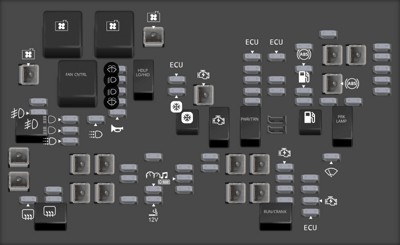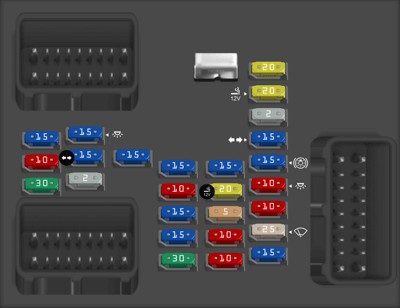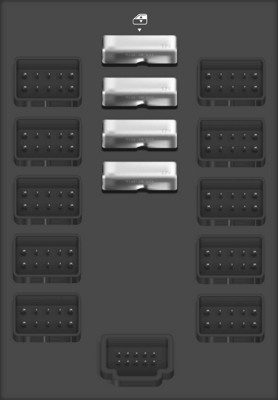Understanding the fuse box system in your 2008 Cadillac Escalade is crucial for maintaining its electrical components. Locating the correct fuse, especially for the OBD2 port, can save you time and prevent unnecessary trips to a mechanic. This guide will help you identify the fuse boxes and pinpoint fuses that may be related to your Escalade’s On-Board Diagnostics system.
Your 2008 Cadillac Escalade is equipped with three distinct fuse boxes, each serving different vehicle systems. Knowing their locations and layouts is the first step in troubleshooting any electrical issue, including problems with your OBD2 port.
Fuse Box Locations on the 2008 Cadillac Escalade
-
Underhood Fuse Block: This fuse box is situated in the engine compartment. It houses fuses and relays for critical engine and powertrain components.
-
Instrument Panel Fuse Block: Located inside the vehicle, this fuse box is usually found on the driver’s side dashboard area. It protects circuits for interior electronics and controls.
-
Center Instrument Panel Fuse Block: This third fuse box is also located within the interior, often in the center console or a similar area. It manages fuses for various convenience features.
Identifying Potential OBD2 Related Fuses
While the diagrams do not explicitly label an “OBD2 fuse”, several fuses are crucial for the operation of the Engine Control Module (ECM) and related systems, which are essential for OBD2 functionality. If you are experiencing issues with your OBD2 port, checking these fuses is a good starting point.
Underhood Fuse Block – Potential OBD2 Fuses:
This fuse box contains fuses that power the engine control systems. Fuses related to the ECM or powertrain are likely candidates if your OBD2 port is not functioning.
| Fuse Number | Type | Description |
|---|---|---|
| 4 | Fuse MINI | Engine Controls |
| 5 | Fuse MINI | Engine Control Module, Throttle Control |
| 12 | Fuse MINI | Engine Control Module (Battery) |
| 14 | Fuse MINI | Transmission Control Module (Battery) |
| 19 | Fuse MINI | Transmission Controls (Ignition) |
| 56 | Fuse MINI | Engine Control Module, Secondary Fuel Pump (Ignition) |



- Fuse 4 “Engine Controls” and Fuse 5 “Engine Control Module, Throttle Control”: These fuses directly relate to the engine’s control systems. A blown fuse here could disrupt power to the ECM, affecting OBD2 port operation.
- Fuse 12 “Engine Control Module (Battery)”: This provides constant battery power to the ECM, which is necessary for its basic functions and memory, potentially including OBD2 port readiness.
- Fuse 14 “Transmission Control Module (Battery)” and Fuse 19 “Transmission Controls (Ignition)”: While primarily for the transmission, these systems are integrated with the engine management system and could indirectly affect OBD2 diagnostics if they are not functioning due to a fuse issue.
- Fuse 56 “Engine Control Module, Secondary Fuel Pump (Ignition)”: Another fuse related to the ECM and fuel delivery, essential systems for engine operation and diagnostics.
Why Check These Fuses for OBD2 Issues?
The OBD2 port relies on the vehicle’s computer systems to function. The ECM is the primary computer that communicates diagnostic information through the OBD2 port. If the ECM is not properly powered due to a blown fuse, the OBD2 port will likely be non-responsive.
Important Note: Always refer to your 2008 Cadillac Escalade owner’s manual for the most accurate fuse box diagrams and fuse descriptions. Fuse layouts can sometimes vary slightly depending on the specific vehicle options and production date. If you are unsure about which fuse to check or how to safely replace a fuse, consult a qualified automotive technician.
By systematically checking these potential fuses in your 2008 Cadillac Escalade’s underhood fuse box, you can effectively troubleshoot and resolve issues related to your OBD2 port, ensuring you can properly diagnose your vehicle’s health.
